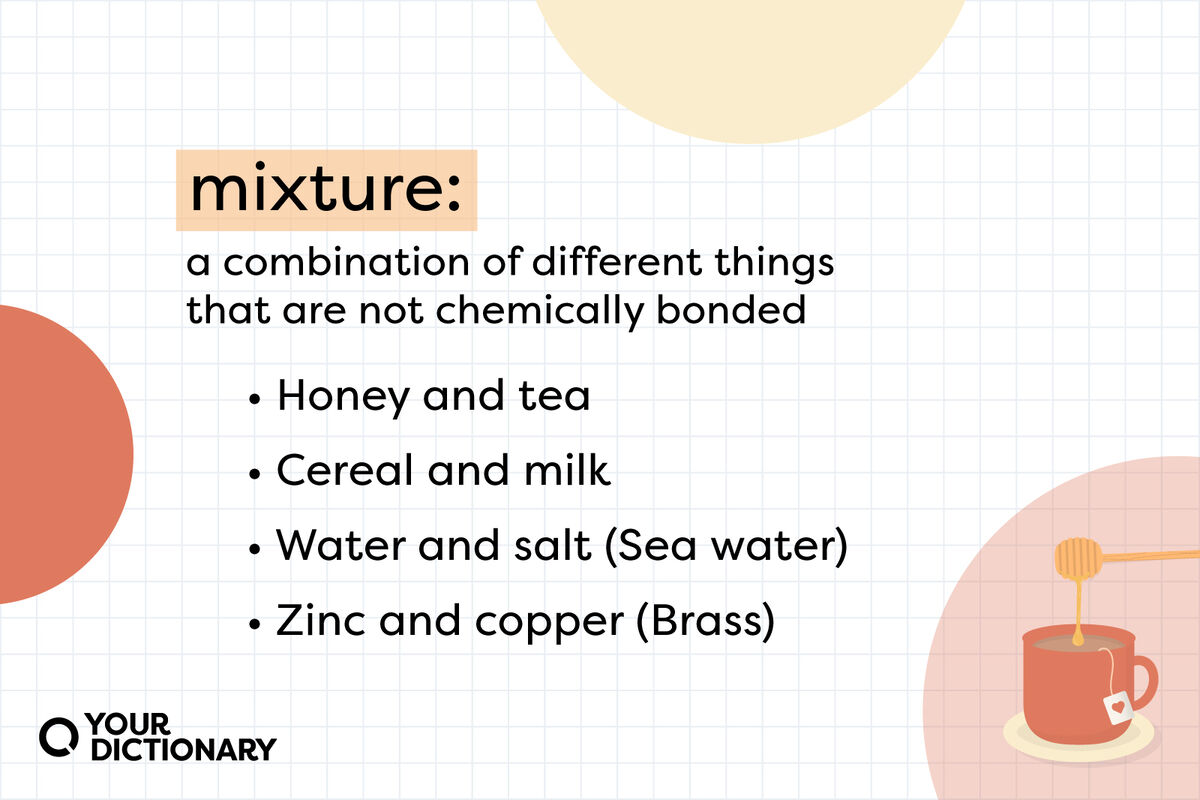
Mixtures are everywhere. The definition of a mixture is a combination of different things that are not chemically bonded. For example, when we bake a cake, it’s a result of a mixture of eggs, flour, sugar, and other ingredients. Mixtures can also be much simpler than that.
Any time two or more items are combined, a mixture is formed. Sometimes, the different parts of a mixture can be separated into individual entities. Other times, they’re married for as long as they exist. An example of a mixture is adding loose leaf tea to hot water, creating a simple kind of mixture that we call tea. Let’s explore more examples of mixtures.
Common Mixtures of Food
Most of the food we eat is a combination of different things. Rarely do we eat only one ingredient. For example, we can eat plain chicken, but why not mix it with a little seasoning? Here are more examples of mixtures as they relate to one of American’s favorite pastimes: eating.
- Oil and water
- Lemon juice and tea
- Honey and tea
- Milk and chocolate
- Coffee and cream
- Cream and sugar
- Flour and butter
- Cereal and milk
- Oatmeal and raisins
- Flour and milk
- Orange juice and champagne
- Sugar and water
- Sugar and tea
- Tonic water and lime juice
- Soda and vanilla syrup
Food mixtures are often heterogeneous mixtures. A heterogeneous mixture is such that the components can be separated from one another. A bowl of Cheerios, for example, is heterogeneous because you can literally pull out the individual pieces of cereal from the milk.
Other Common Mixtures
Beyond the things we eat, our environments are full of other mixtures. Anytime you light a scented candle, you’re introducing aromas into the air, creating a new mixture in the environment. Here are a few more examples:
- Smoke and fog (Smog)
- Dirt and water (Mud)
- Sand, water and gravel (Cement)
- Water and salt (Sea water)
- Potassium nitrate, sulfur, and carbon (Gunpowder)
- Oxygen and water (Sea foam)
- Petroleum, hydrocarbons, and fuel additives (Gasoline)
- Minerals, organic materials, air, water, and living organisms (Soil)
- Chlorine, caustic soda, and water (Bleach)
- Plasma, white blood cells, red blood cells, and platelets (Blood)
The opposite of heterogeneous mixtures is homogeneous mixtures. These are mixtures that are uniform throughout their composition. An example of a homogeneous mixture would be something like lemonade. Once mixed, you can’t easily separate the lemon juice from the water; it's uniformly mixed. Another example is the air we breathe. It’s a homogenous mixture of oxygen, nitrogen, argon, carbon dioxide, and other gases.
Alloy Mixtures
Some of the most important mixtures are strong metals called alloys. These metals are the result of combining two or more metals together, typically in order to strengthen them.
Here’s a list of alloys:
- Aluminum, nickel, and cobalt (Alnico)
- Nickel, manganese, aluminum, and silicon (Alumel)
- Copper and arsenic (Arsenical copper)
- Copper and silver (Billon)
- Zinc and copper (Brass)
- Silver and copper (Britannia silver)
- Nickel and chromium (Chromel)
- Copper and nickel (Constantan)
- Copper and tungsten (Copper-tungsten)
- Copper, gold, and silver (Corinthian bronze)
- Copper, nickel, and iron (Cunife)
- Copper and nickel (Cupronickel)
- Copper, aluminum, and zinc (Devarda's alloy)
- Copper and aluminum (Duralumin)
- Copper, gold, and silver (Electrum)
- Nickel and iron (Elinvar)
- Iron, nickel and cobalt (Fernico)
- Nickel, copper, and zinc (German silver)
- Silver, copper, and gold (Goloid)
- Copper, and a small proportion of gold and silver (Hepatizon)
- Copper, manganese, and tin (Heusler alloy)
- Nickel, chromium, and iron (Inconel)
- Nickel and iron (Invar)
- Potassium and lithium (KLi)
- Nickel, cobalt, and iron (Kovar)
- Copper, manganese, and nickel (Manganin)
- Lead and copper (Molybdochalkos)
- Copper, nickel, iron, manganese, carbon and silicon (Monel metal)
- Nickel and iron (Mu-metal)
- Chromium, iron, and nickel (Nichrome)
- Nickel, chromium, silicon, and magnesium (Nicrosil)
- Nickel and silicon (Nisil)
- Copper, aluminum, zinc, and tin (Nordic gold)
- Tin, copper, antimony, bismuth, and (sometimes) silver (Pewter)
- Silver and platinum (Platinum sterling)
- Gold, silver copper (Rose gold)
- Copper and gold (Shakudo)
- Silver and copper (Shibuichi)
- Aluminum and silicon (Silumin)
- Lead and tin (Solder)
- Iron, manganese, carbon, and silicon (Spiegeleisen)
- Chromium, nickel, molybdenum, silicon, aluminum, and carbon (Stainless steel)
- Carbon and iron (Steel)
- Silver and copper (Sterling silver)
- Lead and tin (Terne)
- Copper and gold (Tumbaga)
- Lead, tin, and antimony (Type metal)
- Zinc, aluminum, magnesium, and copper (Zamak)
Science Is All Around Us
Isn’t it interesting to consider how science is all around us? It’s in the food we eat and the air we breathe. And, the more we experiment with it, the more we uncover various truths about it. The best way to learn new things is by forming hypotheses and following the scientific method to test those hypotheses. For more on this, take a look at these Examples of Hypothesis and then see if you can test them through the scientific method. Happy exploring!